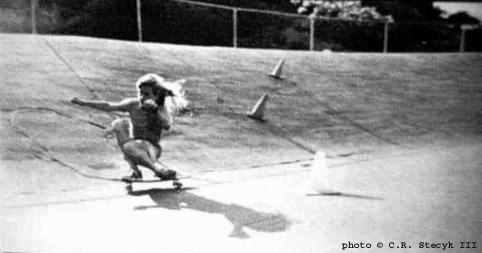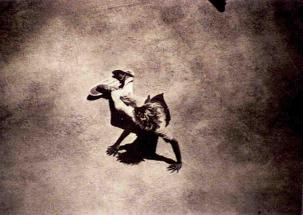SkateBoarder Magazine
Vol. 2, No. 2
Fall 1975
By Carlos Izan
Somewhere in the Arizona desert lies the estate of Barry Goldwater. In his front
yard, amidst the rock and cactus garden stands a flagpole topped by a spot light,
an electric fan and a screaming chrome eagle. The fan blows Barry's flag to keep
it erect, while the spot illuminates it 24 hours, day in and day out.
 Tourists
make the pilgrimage to this opulent shrine of patriotism in air-conditioned,
Gray Line tour buses. Two buses arrive every 45 minutes. A few miles away in one of his department stores, clerks and clerkettes sell skateboards hand over fist. The manager tells that they can't keep enough skateboards in stock he also
confides that Senator Goldwater feels them a public hazard, and consequently is
moving to have them outlawed in the Arizona legislature.
Tourists
make the pilgrimage to this opulent shrine of patriotism in air-conditioned,
Gray Line tour buses. Two buses arrive every 45 minutes. A few miles away in one of his department stores, clerks and clerkettes sell skateboards hand over fist. The manager tells that they can't keep enough skateboards in stock he also
confides that Senator Goldwater feels them a public hazard, and consequently is
moving to have them outlawed in the Arizona legislature.
"The thing about skating banks is that
if you really fall, you really get hurt."
Tony Alva
We were standing by the frozen food counter at the Lucky Market on the edge of Ocean Park Heights. In the Heights the kids skate with an undeniable aggressive proficiency that prompts outsiders to call the area "Skate Town." (In street gang logistics,
 Skate Town is located between Dogtown, Ghost Town, Smogtown, downstream from Frogtown and south of Kosher Canyon). The nine and ten year olds in Skate Town traverse hills at 30 m.p.h., the bigger kids go faster. Anyhow, up to the frozen foods strides a local legend and true veteran of the psychedelic wars known only as Spencer. Under Spence's coiled arm is the latest weapon in his skate arsenal, a forty-five inch arrow board with appropriate cosmic airbrush designs. Looking guardedly about, the skate jockey whispers that he is going to ride out a well-known back canyon grade of about twenty-three miles in length. He also divulges some other cosmic and demonic truths that will govern his down-canyon attempt. At this point, it's probably worth noting that this canyon has been the site of numerous automobile mishaps caused by brake failure on the steep curves. The sheriff's mountain rescue squad regularly combs the canyon floor looking for wrecks. Out of Lucky Market, into the black of midnight, Spencer streaked straight to Diamond Back summit. Without a moment's hesitation, he pushed off for fifty yards and hurtled straight down the hill out of sight.
Skate Town is located between Dogtown, Ghost Town, Smogtown, downstream from Frogtown and south of Kosher Canyon). The nine and ten year olds in Skate Town traverse hills at 30 m.p.h., the bigger kids go faster. Anyhow, up to the frozen foods strides a local legend and true veteran of the psychedelic wars known only as Spencer. Under Spence's coiled arm is the latest weapon in his skate arsenal, a forty-five inch arrow board with appropriate cosmic airbrush designs. Looking guardedly about, the skate jockey whispers that he is going to ride out a well-known back canyon grade of about twenty-three miles in length. He also divulges some other cosmic and demonic truths that will govern his down-canyon attempt. At this point, it's probably worth noting that this canyon has been the site of numerous automobile mishaps caused by brake failure on the steep curves. The sheriff's mountain rescue squad regularly combs the canyon floor looking for wrecks. Out of Lucky Market, into the black of midnight, Spencer streaked straight to Diamond Back summit. Without a moment's hesitation, he pushed off for fifty yards and hurtled straight down the hill out of sight.
 That was the last anyone ever saw of him. His friends figure he rode it out and went off in search of steeper flights.
That was the last anyone ever saw of him. His friends figure he rode it out and went off in search of steeper flights.
"There's more energy existing right now
in isolated pockets of skateboarding
than there is right now in surfing collectively."
Skip Engblom
In a secluded beach community north of Malibu, a scruffy figure guides a skateboard in and out of imaginary slalom gates. The technique is more than adequate, and the skater seems vaguely familiar. Another observer, a resident of the area, clarifies the identity question by stating it's Bob Dylan, and adds that "he skates frequently at night, usually alone or occasionally with one of the Dragon brothers." We nod to the living legend and pass down the walkway, leaving him to his solitary slalom. We both flash that if San Fernando Drew (via Laguna Niguel) could see this, he would
 immediately begin drafting the paramount skate sonnet, a parable disclosing the socio-political implications of the skateboard movement as they relate to the lost generation of the 60's.
immediately begin drafting the paramount skate sonnet, a parable disclosing the socio-political implications of the skateboard movement as they relate to the lost generation of the 60's.
Downhill somewhere past 45, the fine line fluctuates. It's at a different place and time for each rider, but after 45, it becomes increasingly apparent. An alI- compassing awareness of an impending bad situation. Something you pay no attention to, yet somehow can't ignore. An entity you don't want to look at, yet have the urge to see. Downhill, one inch to either side or one inch past this intangible line and it suddenly becomes a physical presence. By the time you see this line, it's all over anyway; the only thing left to do is reassess your mistakes, get down and try to find it again. The really interesting thing about the line is that it keeps increasing. A year ago, it was at 40 for most; now it's beyond 50. People keep pushing this line, oblivious to all else, maybe someday soon they will tie it into knots.
 "They (police) chased us off the schoolyards ... and out into the streets.
"They (police) chased us off the schoolyards ... and out into the streets.
Now
they want us back in the schoolyards."
Wentzle Ruml
Most people probably won't understand some of this, but that really doesn't matter since the intrinsic elements of this discussion are meant for those who really skate (just owning a skateboard or the old "I was into it ten years ago, so I understand it now," doesn't qualify one as a skater). Modern skateboarding is a constantly evolving hybrid very few comprehend. In dealing with the old versus the new, one must take several things into consideration. First, the "high state of the art" premise is a pile of crap. At the present time, there is little being done that is a radical departure from the 1960's. The freestyle area is just coming up to the level of the mid-60's. (The big difference here is that there are more people now who are closing in on the advanced levels). In the downhill and slalom, there are increasing numbers who participate (their confidence being based upon the soft grip of the urethane wheel). All that can be said here is that the validity or
lack of it in an objective speed situation is obvious. The composition wheels of the pre-urethane era offered a harder, faster rolling surface, and generally speaking, 40 m.p.h. ten years ago was more of an accomplishment than it is today. In fact, many of the older slalom/downhill boys seem to be doing quite well today, perhaps due to having learned on faster rolling, poorer gripping equipment. In other words, they have got their act down.
 At this current juncture. one must keep in mind that these days are the infancy of the neo-skate renaissance. The big breakthroughs are yet to come, since the current practitioners really haven't even begun to reach their marks.
At this current juncture. one must keep in mind that these days are the infancy of the neo-skate renaissance. The big breakthroughs are yet to come, since the current practitioners really haven't even begun to reach their marks.
As for skate technology, it's just starting to improve; up to this point, the vast majority of products on the market are fast buck oriented, ten year old trips. The better skaters will create a demand for better equipment, and the better manufacturers will fill it. As a reference point it would be interesting to see some of these skateboard manufacturers forced into a 40 m.p.h. run on their own equipment - this would really separate the men from the boys.
In retrospect, the last time around, the hotter skaters pushed it as far as they could go. To a great extent, they helped bring about the short ski-short surfboard revolution, since their refined technique far surpassed the more stationary orientations of the long ski and long stick trip. Abilities and attitudes honed on a 24"-36"skate could no longer confine themselves to surfing in place on a 9'6"; i.e., 114 inches.
It will be enlightening to see what
 sort of changes the current crop of skaters brings about in related fields in the not so distant future.
sort of changes the current crop of skaters brings about in related fields in the not so distant future.
People have been surf skating banks for 15 years. In the 60's, many of these people existed outside of the syndrome of the competition/exhibition team. It was impossible to transport the bank situation to the department stores and shopping centers across America.
Bank riding represents a three-dimensional opportunity - a downhill gradient as modified by the degree of side slope and contours such as bowls, moguls, twists, cracks and other factors around which you must constantly readjust.
If the present formal competitive structure is to become relevant to the real challenges and esoteric rewards inherent in skateboarding, the movement must become sensitive to the realities by not reducing skateboarding to a conveniently packaged commodity.


